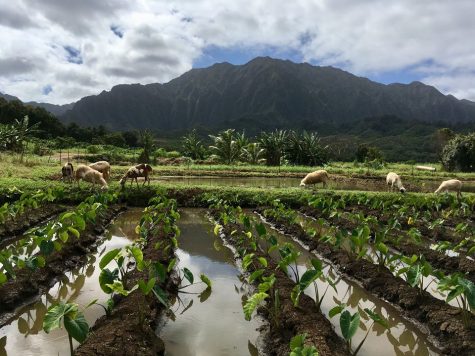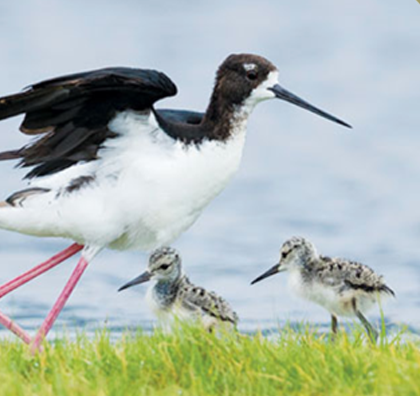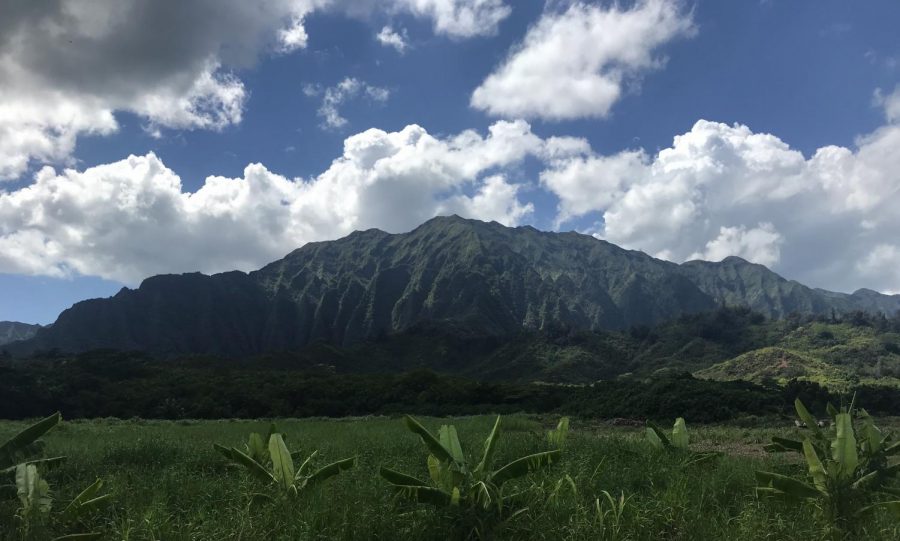Located on the Windward side of Oahu, Ahupua‘a He‘eia was traditionally one of the largest areas for cultivating wetland kalo on the island. In more recent years it has become overgrown with invasive species, stopping the use of loʻi kalo. Now Kāko‘o ‘Ōiwi, a local nonprofit organization, is working in partnership with The Nature Conservancy to help restore the native wetlands that once inhabited the area and to strengthen the He‘eia community through traditional food production.
According to the Hawaii Department of Agriculture’s estimates, Hawaii imports between 85-90% of its food annually, meaning that only 10-15% of our food is produced locally. We have an undeniable reliance on imports, and with that comes the potential for major problems. An event such as a natural disaster or global incident could delay or prevent shipments from arriving in Hawaii. It has been estimated that there is only five to seven days of food supply across the islands, meaning that a disruption to the state’s imports could be detrimental.
Our dependence on imported goods is alarming, and the impact that they have on our environment is just as significant. Not only do imported goods have a tremendous carbon footprint from transport, but they often come heavily packaged, creating even more waste. Local agriculture is a reliable way to ensure that food is being generated for the islands while also dramatically reducing carbon emissions and packaging waste. According to Kanekoa Kukea-Shultz, executive director of Kāko‘o ‘Ōiwi, if traditional Hawaiian agriculture methods were used today in our island’s marginal lands (areas unsuitable for industrial agriculture) the food produced could feed around ¼ of the population of Oʻahu. Using techniques such as loʻi kalo and other traditional methods would improve Hawaii’s food security while simultaneously reducing waste.

Hawaiian agriculture techniques don’t just promote sustainable methods of improving food security, but also ensure that the community benefits. The main goal of Kāko‘o ‘Ōiwi is producing enough food to sustain the community while being environmentally conscious. “The balance is basically how much the community needs versus how much the environment can support… Our goal is to support the community,” says Ikaika Bishop, class of 2000 Punahou graduate and Farm Specialist at Kāko‘o ‘Ōiwi.
Maintaining a connection to the land for the community of He‘eia is one of the most important aspects of Kāko‘o ‘Ōiwi. “If you remove the people, then the stories aren’t told, and the history is forgotten,” says Kukea-Shultz. Wetland and native ecosystems restoration maintains a high level of cultural significance in He‘eia. Nick Reppun, Punahou Graduate ’05 and the Farm Director of Kāko‘o ‘Ōiwi, believes that supporting the native community by connecting them to their roots is essential. “Kāko‘o ‘Ōiwi, it’s in our name, to support native. Everything we do has that underlying philosophy… Supporting our native ecosystems, supporting our native communities, and supporting native agriculture.” By involving the local community in sustainable and local agriculture, people can maintain a connection to the land while coming closer together and benefiting the planet. To help achieve the goal of maintaining a connection to the history of He‘eia and its agriculture techniques, traditional Hawaiian staple crops are being utilized, including mai‘a (banana), ‘ulu (breadfruit), wetland kalo (taro), and uala (sweet potato).
Alongside food production, wetland restoration is an equivalent part to Kāko‘o ‘Ōiwi’s mission and work. Mangroves, an invasive species, have taken over large areas of Kaneohe Bay, pushing out native species and damaging the native ecosystems. Kāko‘o ‘Ōiwi is working on clearing the mangroves in order to replant native species, restoring the native wetlands to promote the return of native birds and fish, and stabilizing the environment.

This restoration of the wetlands has already shown considerable results. Many native species of birds and fish are returning to He‘eia, like the endemic and highly endangered ae‘o, or Hawaiian Stilt. “That’s ae‘o, [which was] something we never heard when we first started Kāko‘o ‘Ōiwi,” says Kukea-Shultz while explaining the impact of wetland restoration. The restored areas have also brought back many other bird species including ‘Alae ‘Ula, Koloa ducks, and Kōlea. “Seeing all the birds come back in is one of our indicators of success,” says Reppun. Along with birds, some species of native freshwater fish have also returned to He‘eia, including o‘opu. Native wetlands are essential ecosystems to the health and protection of our native species, and as Kāko‘o ‘Ōiwi continues to help restore the wetlands, the hope is that more native species will be able to thrive.
In our continually changing world, it’s important to remember to look at what’s happening around us. There are so many opportunities here on Oahu to help improve our food security, restore our environment, and get involved in our communities to impact the diversity and beauty of our native wildlife and maintain our sense of place here in our islands. It is essential that we work to protect our native ecosystems for the future of Hawaii, not only to help build back up our native and endangered species populations, but to promote sustainability and prevent the loss of what makes Hawaii so special: the natural places, unique wildlife, and the prevalent sense of community.

